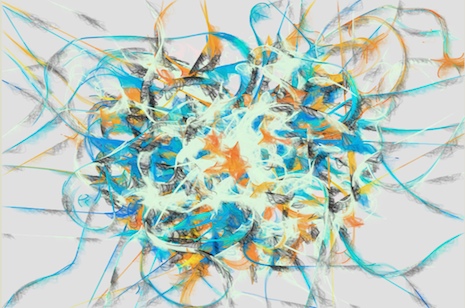
Until recently, a piece of art was a physical object that hung on a wall or rested in a sculpture garden. With today's digital technologies, however, art can be downloaded, emailed, uploaded onto social media exhibited on the Internet. Russell Deaton, professor of computer science and computer engineering, uses his programming and engineering skills to create computer-based algorithmic art.
Deaton recently displayed a piece of digital art titled Florida Earth/Sky at the 4th Annual Digital Graffiti festival in Alys Beach, Fla. Digital Graffiti, the world's first projection art festival, features dynamic digital images that are projected onto buildings.
When creating Florida Earth/Sky, Deaton used ideas from his research on nanoparticles. Deaton and his colleague, biological engineering professor Jin-Woo Kim, attach DNA to nanoparticles, and the DNA directs them as they self-assemble into larger structures.
In Deaton's digital art piece, particles move and interact according to an algorithm that is based on the interactions of the nanoparticles he studies, and they also self-assemble to form different images.
"If two particles get within a certain distance of each other, they'll react, so they'll be attached," Deaton explained. "Once they're attached, it affects their movement, and there are different colors and different types of visualizations based upon that bonding."
Using algorithms creates complexity in the art, Deaton explained. "I don't want to do things that are random; that's too easy. There's some structure underneath in the program that's running, and I think there is some order and structure in the visualization."
Other elements of the piece were inspired by a sabbatical Deaton spent in Korea. "The square is the earth and the circle is the sky in Eastern aesthetic," he explained. In Deaton's piece, the frame is a square, and an invisible boundary in the middle of the frame changes the movement of the particles, causing them to eventually fill in a circle.
Deaton is also using the concept of self-assembly to generate more realistic settings for role-playing games. Using self-assembly, a game could create completely new environments instead of using the same script over and over. He is also working with Santiago Perez in the Fay Jones School of Architecture to create self-assembled environments, which would change according to the preferences of people in them.
A video of the Florida Earth/Sky applet in action may be viewed here.
Contacts
Camilla Medders, director of communications
College of Engineering
(479) 575-5697, camillam@uark.edu